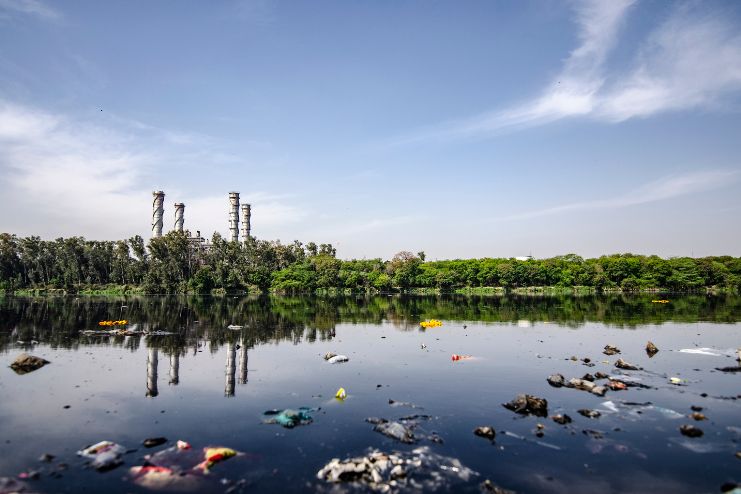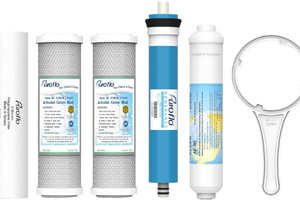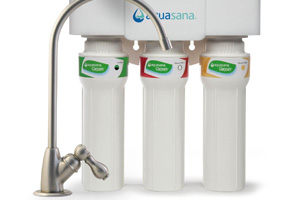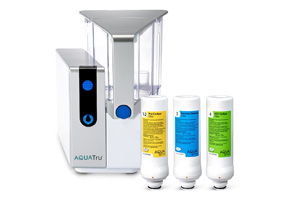Affiliate Disclaimer
Some links in this article are affiliate links. We may earn a small commission if you make a purchase through these links, at no extra cost to you. We only recommend products we find useful to our readersHave you ever wondered what’s really in your tap water? Scientists have discovered a group of chemicals called PFAS (per- and polyfluoroalkyl substances) that have been linked to serious health risks. These chemicals, also known as “Forever Chemicals”, are found in everyday items and have made their way into drinking water supplies.
The big problem? PFAS do not break down easily and can persist in the environment and the human body for extended periods. This article explains what PFAS are, why they pose a health risk, and how to reduce exposure to these chemicals in your tap water through practical measures.
What Are PFAS and Why Are They Called “Forever Chemicals”?
PFAS are synthetic chemicals used across various industries since the 1940s. You can find them in:
- Non-stick cookware (suchas Teflon)
- Waterproof and stain-resistant clothing
- Firefighting foam
- Fast food packaging
The chemicals repel water, oil, and heat, making them suitable for a wide range of products. PFAS resist breakdown due to their strong carbon-fluorine bonds, allowing them to persist in the environment for a long time. These same properties also make them toxic, as they accumulate and cause widespread contamination. Hence the name, “forever chemicals.”
Read More: Common Household Toxins You Didn’t Know Could Be Harming Your Health
How do PFAS get into Tap Water?

PFAS contamination occurs when these chemicals make their way into the environment through:
- Factory waste from plants that employ PFAS.
- Runoff from firefighting foam, particularly around military bases and airports.
- Landfills and wastewater treatment facilities.
Certain states in the U.S., like Michigan, California, and New Jersey, have reported high PFAS levels in their water supplies. You may face contamination if your area has a history of industrial pollution. If that is the case, you might face certain health hazards.
Let us learn more about those in the next section.
Health Risks of PFAS Exposure

Research indicates that PFAS exposure can cause short-term and long-term health issues, impacting various systems within the body.
Short-Term Health Risks:
- Hormonal Imbalance: PFAS may disrupt hormone production, potentially leading to metabolic, growth, and reproductive disorders.
- Changes in Liver Function: The liver filters toxins, and PFAS exposure increases liver enzymes and alters cholesterol levels.
Long-Term Health Risks:
- Cancer Risk: Research has established links between PFAS exposure and kidney, liver, and testicular cancer, probably caused by their capacity to change cellular function and enhance tumor growth.
- Immune System Issues: PFAS can weaken the immune system, making a person more susceptible to infections and weakening their response to vaccines.
- Thyroid Problems: The chemicals may interfere with thyroid hormones, which control metabolism, energy, and endocrine health in general.
- Developmental Issues: Studies show that PFAS exposure in pregnant women increases the risk of low birth weight, birth defects, and developmental delays in their children.
- Metabolic Effects: Studies associate PFAS with obesity, diabetes, and high cholesterol because these chemicals can disrupt fat and sugar metabolism.
More research is needed, but experts warn that long-term exposure could have severe consequences. Now that we are aware of the health risks of “forever chemicals”, it is crucial to understand the safety levels of PFAS.
Read More: 4 Eco-Friendly Food Packaging Options: What to Choose and What to Avoid
Are There Safe Levels of PFAS in Drinking Water?

The US Environmental Protection Agency (EPA) has set non-enforceable health advisories for some PFAS chemicals. Yet, most scientists do not agree with the “safe” level of exposure. Even trace amounts may pose long-term risks since PFAS accumulate silently over time.
Lack of Enforce ability: Since these advisories aren’t legally binding, regulators don’t require public water systems to test for or treat PFAS contamination beyond these levels.
Scientific Concerns: Certain research suggests that even trace levels of PFAS in drinking water may be harmful, emphasizing the need for rigorous water testing, improved filtration methods, and stronger regulations to safeguard public health.
Bottled Water vs.Tap Water
- Some bottled water brands may also contain PFAS, so switching to bottled water doesn’t necessarily eliminate PFAS exposure.
- The best way to ensure your water is safe is through filtration and regular testing.
How to Reduce PFAS Exposure from Tap Water

Reducing exposure to PFAS is key to maintaining long-term health, given that these compounds accumulate in the body over time. Regulations are changing, but you can take the necessary steps early to reduce exposure. Here’s how!
1. Test Your Water:
- Home testing kits can help detect PFAS levels in your tap water.
- Check the water quality report of the local utility to know about the contamination levels and safety guidelines.
2. Use the Right Water Filters:
Not all filters are capable of removing PFAS. Look for:
- Reverse osmosis (RO) filters are highly effective at filtering out PFAS.
Check the following links for some popular RO filters available online:

2. Aquasana Under Sink Water Filter System – Reduces PFAS, Lead, & Chlorine in Drinking Water.

3. AquaTru Classic Countertop Water Filtration Purification System for PFAS & Other Contaminants

- Activated carbon filters, but only high-quality brands with proven PFAS reduction capabilities.
If you wish to access credible information and product listings related to PFAS, visit PFAS Central and the Green Science Policy Institute website.
3. Reduce PFAS in Everyday Life:
PFAS are common in household items, so small adjustments can reduce your exposure:
- Use PFAS-free cookware, like stainless steel or ceramic, versus non-stick pans.
- Avoid fast food and processed food since PFAS in some packaging can leach into the food.
- Use PFAS-free personal care products such as makeup, lotions, and sunscreens.
By taking these measures, you can significantly reduce your exposure to PFAS. However, we must work towards tighter regulations and a safer water supply, which will help in the long run.
Read More: Best At-Home Food Sensitivity Test Kits to Identify Hidden Intolerances
Conclusion

Since PFAS are nearly impossible to eliminate once they enter the body or ecosystem, early awareness and action are essential. While regulators are tightening policies, you can do your bit, too. Act today to reduce your exposure by having your water tested, using the right filters, and avoiding common products that contain PFAS.
By being diligent and making slight changes, you can protect yourself and your loved ones against the health risks posed by PFAS in tap water.
References
- https://www.sciencedirect.com/science/article/pii/S0147651323011673
- https://www.sciencedirect.com/science/article/pii/S0160412024004306
- https://www.sciencedirect.com/science/article/pii/S0160412024004306
- https://www.epa.gov/pfas/our-current-understanding-human-health-and-environmental-risks-pfas
- https://www.nrdc.org/stories/forever-chemicals-called-pfas-show-your-food-clothes-and-home
In this Article


















